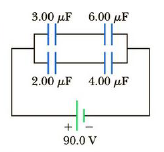
Concept explainers
For the system of capacitors shown in Figure P16.41, find (a) the equivalent capacitance of the system, (b) the charge on each capacitor, and (c) the potential difference across each capacitor.

Figure P16.41 Problems 41 and 60.
(a)
The equivalent capacitance.
Answer to Problem 41P
The equivalent capacitance is 3.33 μF.
Explanation of Solution
The capacitors 6.00 μF and 3.00 μF are connected in series combination. The equivalent capacitance is,
Ctp=C6.00 μFC3.00 μFC6.00 μF+C3.00 μF
The capacitors 2.00 μF and 4.00 μF are connected in series combination. The equivalent capacitance is,
Cbp=C2.00 μFC4.00 μFC2.00 μF+C4.00 μF
The capacitances Ctp and Cbp are in parallel combination. The total equivalent capacitance is,
Ceq=Ctp+Cbp
Therefore,
Ceq=(C6.00 μFC3.00 μFC6.00 μF+C3.00 μF)+(C2.00 μFC4.00 μFC2.00 μF+C4.00 μF)
Substitute 6.00 μF for C6.00 μF,3.00 μF for C3.00 μF,2.00 μF for C2.00 μF and 4.00 μF for C4.00 μF
Ceq=[(6.00 μF)(3.00 μF)(6.00 μF)+(3.00 μF)]+[(2.00 μF)(4.00 μF)(2.00 μF)+(4.00 μF)]=3.33 μF
On Re-arranging,
Ceq=8.00 μF3=2.67 μF
Conclusion:
The equivalent capacitance is 3.33 μF.
(b)
The charge on each capacitor.
Answer to Problem 41P
The charge on 6.00 μF and 3.00 μF capacitors is 180 μC
The charge on 2.00 μF and 4.00 μF capacitors is 120 μC
Explanation of Solution
Formula to calculate the charge on 6.00 μF and 3.00 μF capacitors is,
Q1=CtpV
Therefore,
Q1=(C6.00 μFC3.00 μFC6.00 μF+C3.00 μF)V
Substitute 6.00 μF for C6.00 μF,3.00 μF for C3.00 μF and 90.0 V for V.
Q1=((6.00 μF)(3.00 μF)(6.00 μF)+(3.00 μF))(90.0 V)=180 μC
Formula to calculate the charge on 2.00 μF and 4.00 μF capacitors is,
Q2=CbpV
Therefore,
Q2=(C2.00 μFC4.00 μFC2.00 μF+C4.00 μF)V
Substitute 2.00 μF for C2.00 μF,4.00 μF for C4.00 μFC3.00 μF and 90.0 V for V.
Q2=((2.00 μF)(4.00 μF)(2.00 μF)+(4.00 μF))(90.0 V)=120 μC
Conclusion:
The charge on 6.00 μF and 3.00 μF capacitors is 180 μC
The charge on 2.00 μF and 4.00 μF capacitors is 120 μC
(c)
The potential difference on each capacitor.
Explanation of Solution
The potential difference on 2.00 μF and 3.00 μF capacitors is 60 V
The potential difference on 6.00 μF and 4.00 μF capacitors is 30 V
Formula to calculate the potential difference on 2.00 μF and 3.00 μF capacitors is,
V=Q2C2.00 μF
Substitute 120 μC for Q2 and 2.00 μF for C2.00 μF
V=120 μC2.00 μF=60 V
Formula to calculate the potential difference on 6.00 μF and 4.00 μF capacitors is,
V=Q2C6.00 μF
Substitute 180 μC for Q1 and 6.00 μF for C6.00 μF
V=180 μC6.00 μF=30 V
Conclusion:
The potential difference on 2.00 μF and 3.00 μF capacitors is 60 V
The potential difference on 6.00 μF and 4.00 μF capacitors is 30 V
Want to see more full solutions like this?
Chapter 16 Solutions
College Physics 11E Global Edition
- RT = 4.7E-30 18V IT = 2.3E-3A+ 12 38Ω ли 56Ω ли r5 27Ω ли r3 28Ω r4 > 75Ω r6 600 0.343V 75.8A Now figure out how much current in going through the r4 resistor. |4 = unit And then use that current to find the voltage drop across the r resistor. V4 = unitarrow_forward7 Find the volume inside the cone z² = x²+y², above the (x, y) plane, and between the spheres x²+y²+z² = 1 and x² + y²+z² = 4. Hint: use spherical polar coordinates.arrow_forwardганм Two long, straight wires are oriented perpendicular to the page, as shown in the figure(Figure 1). The current in one wire is I₁ = 3.0 A, pointing into the page, and the current in the other wire is 12 4.0 A, pointing out of the page. = Find the magnitude and direction of the net magnetic field at point P. Express your answer using two significant figures. VO ΜΕ ΑΣΦ ? Figure P 5.0 cm 5.0 cm ₁ = 3.0 A 12 = 4.0 A B: μΤ You have already submitted this answer. Enter a new answer. No credit lost. Try again. Submit Previous Answers Request Answer 1 of 1 Part B X Express your answer using two significant figures. ΜΕ ΑΣΦ 0 = 0 ? below the dashed line to the right P You have already submitted this answer. Enter a new answer. No credit lost. Try again.arrow_forward
 College PhysicsPhysicsISBN:9781285737027Author:Raymond A. Serway, Chris VuillePublisher:Cengage Learning
College PhysicsPhysicsISBN:9781285737027Author:Raymond A. Serway, Chris VuillePublisher:Cengage Learning College PhysicsPhysicsISBN:9781305952300Author:Raymond A. Serway, Chris VuillePublisher:Cengage Learning
College PhysicsPhysicsISBN:9781305952300Author:Raymond A. Serway, Chris VuillePublisher:Cengage Learning Physics for Scientists and Engineers: Foundations...PhysicsISBN:9781133939146Author:Katz, Debora M.Publisher:Cengage Learning
Physics for Scientists and Engineers: Foundations...PhysicsISBN:9781133939146Author:Katz, Debora M.Publisher:Cengage Learning Physics for Scientists and EngineersPhysicsISBN:9781337553278Author:Raymond A. Serway, John W. JewettPublisher:Cengage Learning
Physics for Scientists and EngineersPhysicsISBN:9781337553278Author:Raymond A. Serway, John W. JewettPublisher:Cengage Learning Physics for Scientists and Engineers with Modern ...PhysicsISBN:9781337553292Author:Raymond A. Serway, John W. JewettPublisher:Cengage Learning
Physics for Scientists and Engineers with Modern ...PhysicsISBN:9781337553292Author:Raymond A. Serway, John W. JewettPublisher:Cengage Learning Physics for Scientists and Engineers, Technology ...PhysicsISBN:9781305116399Author:Raymond A. Serway, John W. JewettPublisher:Cengage Learning
Physics for Scientists and Engineers, Technology ...PhysicsISBN:9781305116399Author:Raymond A. Serway, John W. JewettPublisher:Cengage Learning





